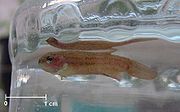
Velvet (fish disease)
Encyclopedia

Dinoflagellate
The dinoflagellates are a large group of flagellate protists. Most are marine plankton, but they are common in fresh water habitats as well. Their populations are distributed depending on temperature, salinity, or depth...
parasites of the genus Piscinoodinium, which gives the fish a dusty, slimy look. The disease occurs most commonly in tropical and (to a lesser extent) marine aquaria.
Life cycle
The single-celled parasite's life cycle can be divided into three major phases. First, as a tomontTomont
Tomont is a protozoan, especially of the Apicomplexa, in the active stage of its life cycle, which develops into an encyst....
, the parasite rests at the water's floor and divides into as many as 256 tomites. Second, these juvenile, motile tomites swim about in search of a fish host, meanwhile using photosynthesis
Photosynthesis
Photosynthesis is a chemical process that converts carbon dioxide into organic compounds, especially sugars, using the energy from sunlight. Photosynthesis occurs in plants, algae, and many species of bacteria, but not in archaea. Photosynthetic organisms are called photoautotrophs, since they can...
to grow, and to fuel their search. Finally, the adolescent tomite finds and enters the slime coat of a host fish, dissolving and consuming the host's cells, and needing only three days to reach full maturity before detaching to become a tomont once more.
Pathology
Velvet (in an aquarium environment) is usually spread by contaminated tanks, fish, and tools (such as nets or testing supplies). There are also rare reports of frozen live foods (such as bloodworms) containing dormant forms of the species. Frequently, however, the parasite is endemic to a fish, and only causes a noticeable "outbreak" after the fish's immune system is compromised for some other reason. The disease is highly contagious and can prove fatal to fish.Symptoms
Initially, infected fish are known to "flash," or sporadically dart from one end of an aquarium to another, scratching against objects in order to relieve their discomfort. They will also "clamp" their fins very close to their body, and exhibit lethargy. If untreated, a 'dusting' of particles (which are in fact the parasites) will be seen all over the infected fish, ranging in color from brown to gold to green. In the most advanced stages, fish will have difficulty respirating, will often refuse food, and will eventually die of hypoxiaHypoxia (medical)
Hypoxia, or hypoxiation, is a pathological condition in which the body as a whole or a region of the body is deprived of adequate oxygen supply. Variations in arterial oxygen concentrations can be part of the normal physiology, for example, during strenuous physical exercise...
due to necrosis
Necrosis
Necrosis is the premature death of cells in living tissue. Necrosis is caused by factors external to the cell or tissue, such as infection, toxins, or trauma. This is in contrast to apoptosis, which is a naturally occurring cause of cellular death...
of their gill tissue.
Treatment
Sodium chlorideSodium chloride
Sodium chloride, also known as salt, common salt, table salt or halite, is an inorganic compound with the formula NaCl. Sodium chloride is the salt most responsible for the salinity of the ocean and of the extracellular fluid of many multicellular organisms...
is believed to mitigate the reproduction of Velvet, however this treatment is not itself sufficient for the complete eradication of an outbreak. Additional, common medications added directly to the fish's environment include copper sulfate, methylene blue
Methylene blue
Methylene blue is a heterocyclic aromatic chemical compound with the molecular formula C16H18N3SCl. It has many uses in a range of different fields, such as biology and chemistry. At room temperature it appears as a solid, odorless, dark green powder, that yields a blue solution when dissolved in...
, formalin, malachite green
Malachite green
Malachite green is an organic compound that is used as a dyestuff and has emerged as a controversial agent in aquaculture. Malachite green is traditionally used as a dye for materials such as silk, leather, and paper...
and acriflavin, all of which can be found in common fish medications designed specifically to combat this disease. Additionally, because Velvet parasites derive a portion of their energy from photosynthesis
Photosynthesis
Photosynthesis is a chemical process that converts carbon dioxide into organic compounds, especially sugars, using the energy from sunlight. Photosynthesis occurs in plants, algae, and many species of bacteria, but not in archaea. Photosynthetic organisms are called photoautotrophs, since they can...
, leaving a tank in total darkness for seven days provides a helpful supplement to chemical curatives. Finally, some enthusiasts recommend raising the water temperature of an infected fish's environment, in order to quicken the life cycle (and subsequent death) of Velvet parasites; however this tactic is not practical for all fish, and may induce immunocompromising stress
Stress (biology)
Stress is a term in psychology and biology, borrowed from physics and engineering and first used in the biological context in the 1930s, which has in more recent decades become commonly used in popular parlance...
.

